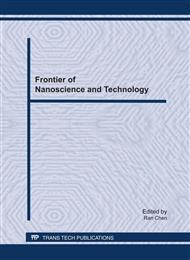[1]
J. Lin, W.L. Zhou, A. Kumbhar et al: Journal of Solid State Chemistry Vol. 159(2001), pp.26-31.
Google Scholar
[2]
P.G. Charles and J.P. Kathy: Nanoclusters Science Vol. 267(1995), pp.1338-1340.
Google Scholar
[3]
M. Aslam, S. Li, and V.P. Dravid: Journal of the American Ceramic Society Vol. 90(2007), pp.950-956.
Google Scholar
[4]
D.H. Chen and S.H. Wu: Chemistry of Materials Vol. 12(2000), pp.1354-1360.
Google Scholar
[5]
J. Raabe, R. Pulwey and R. Sattler et al.: Journal of Applied Physics Vol. 88(2000), pp.4437-4439.
Google Scholar
[6]
S. Ge, C. Li and X. Ma et al.: Journal of Applied Physics Vol. 90(2001), pp.509-511.
Google Scholar
[7]
Y. Mizukoshi, K. Okitsu and Y. Maeda et al.: Journal of Physical Chemistry B Vol. 101 (1997), pp.7033-7037.
Google Scholar
[8]
J.W. Park, E.H. Chae and S.H. Kim et al.: Materials Chemistry and Physics Vol. 97(2006), pp.371-378.
Google Scholar
[9]
H. Bonnnmann, R.A. Brand and W. Brijoux et al.: Applied Organmetallic Chemistry Vol. 19 (2005), pp.790-795.
Google Scholar
[10]
Y. Mizukoshi, K. Okitsu and Y. Maeda et al.: Journal of Physical Chemistry B, Vol. 101(1997), pp.7033-7037.
Google Scholar
[11]
C.H. Griffiths, M.P. O'Horo and T.W. Smith: Journal of Applied Physics Vol. 50(1979), pp.7108-7115.
Google Scholar
[12]
M. L. Steigerwald, A. P. Alivisatos and J. M. Gibson et al.: Journal of the American Chemical Society, Vol. 110 (1988), pp.3046-3050.
Google Scholar
[13]
S. Komarneni, R. Pidugu and Q.H. Li et al. Journal of Material Research Vol. 10 (1995), pp.1687-1692.
Google Scholar
[14]
G. N. Glavee, K.J. Klabunde and C.M. Sorensenet al.: Inorganic Chemistry, Vol. 34(1995), pp.28-35.
Google Scholar
[15]
G.D. Forster, L.F. Barquin and R.L. Bilsborrow et al.: Journal of Materials Chemistry Vol. 9 (1999), pp.2537-2544.
Google Scholar
[16]
J.Y. Shen, Z.Y. Li and Q.J. Yan et al.: Journal of Physical Chemistry Vol. 97(1993), pp.8504-8511.
Google Scholar
[17]
G.N. Glavee, K.J. Klabunde and C.M. Sorensenet al.: Langmuir, Vol. 10 (1994), pp.4726-4730.
Google Scholar
[18]
S. Wells, S.W. Charles and S. Morup et al.: Journal of Physics: Condensed Matterial Vol. 1 (1989), pp.8199-8208.
Google Scholar
[19]
A.M.L. Jackelen, M. Jungbauer, and G.N. Glavee: Langmuir, Vol. 15(1999) P. 2322-2326.
Google Scholar
[20]
Z.Y. Li, C.H. Han and J.Y. Shen: Journal of Materials Science Vol. 41(2006) pp.3473-3480.
Google Scholar
[21]
S. -H. Wu, D. -H. Chen: Journal of Colloid and Interface Science Vol. 259 (2003), pp.282-286.
Google Scholar
[22]
J.H. Hwang, V.P. Dravid and M.H. Teng et al.: Journal of Materials Research Vol. 12(1997), pp.1076-1082.
Google Scholar
[23]
H.T. Zhang, G. Wu and X.H. Chen et al.: Materials Research Bulletin Vol. 41(2001), 495-501.
Google Scholar
[24]
X.M. Ni, Q. B Zhao and H.G. Zheng et al.: European Journal of Inorganic Chemistry Vol. 23 (2005), pp.4788-4793.
Google Scholar
[25]
K. V. P. M. Shafi and A. G. P. Balogh: Chemistry of Materials Vol. 10(1998), pp.3445-3450.
Google Scholar


